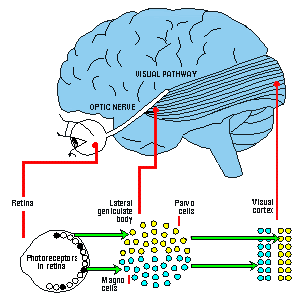According to studies
conducted at the most respected universities in the world (Harvard,
Yale, Cambridge, etc.), it has been demonstrated that dyslexia
could be a physical and not a mental disability. For dyslexic
individuals as well as other people with difficulties in reading
and writing, this discovery means that once the problem has been
detected and diagnosed, it can be treated accordingly. So far
neither opticians nor dyslexia specialists have followed this
line of treatment for individuals suffering from these symptoms,
probably due to ignorance about its existence.
Up to now it has been believed that dyslexics'
ability to imagine and visualise letters and objects in three
dimensions is a mental phenomenon and has been treated accordingly
in centres for dyslexia worldwide.
However, thanks to international studies undertaken by prestigious
research units such as those of Harvard Medical School, Yale,
Cambridge, etc. it has been confirmed that there is a size difference
between the magnocellular pathway of dyslexics and non-dyslexics.
These discoveries prove that the magnocellular pathway in dyslexics
is 27% smaller than in non-dyslexics and consequently the magno
cells are also smaller.

The magnocelular pathway consists of large
nerve cells that form a path from the eyes to the brain and is
responsible for sending signals about large/static images, perspective
of time, space, dimension, sequence - integral problems for dyslexics.
This same pathway is responsible for detecting colours . If the
signal is transmitted with an erroneous frequency a distorted
message will be sent from the eye to the brain, a message that
is difficult to interpret.
ChromagenTM lenses adjust the light entering the eye and allow
the magnocellular pathway to send the signals at a speed which
can be interpreted by the brain without distortions, thus achieving
the same image as other individuals do.
This way, most dyslexics' "three-dimensional" and
distorted vision is remedied and their eye movement controlled
by rectifying the blurred vision many of them did not even realise
they had as they had nothing to compare it with. This adjustment
will also help hyperactivity, ADD, and even epilepsy, also caused
by the imbalance of light perception received through the eye.
This adjustment also results in improved coordination and
a better concept of time and space, as all of these are dependent
on the same pathway.
Not only are these discoveries important in terms of the obvious
benefits they afford but also in preventing an incorrect diagnosis
that may cause further irregularities as a direct consequence
thereof (e.g. the worsening of sight owing to the unnecessary
prescription of glasses up to and including 0.75 or a useless
strabismus surgery).
In spite of the conclusive evidence, including autopsies on
5 dyslexic and 5 non-dyslexic brains, the centres for the treatment
of dyslexia and learning disabilities, opticians, speech therapists,
etc. don't seem to have taken these results into account.
For these specialists, the most suited to identify and evaluate
the benefits of this system for each individual, ChromagenTM lenses
could serve as an effective tool to improve the reading and writing
levels of up to 1 in 4 students. ChromagenTM lenses should be
considered as an important first step when treating these problems,
since individuals will obtain immediate results and the learning
process to be undertaken will have more meaning for them if the
results are positive.
Up to 20% of the population will benefit from ChromagenTM
lenses.
Our goal is to help as many children (and adults) as possible;
please do not hesitate to contact the ChromagenTM practitioner
for an appointment - You have everything to gain and nothing to
lose!
If ChromagenTM is the missing piece of the puzzle, your quality
of life will improve immediately.